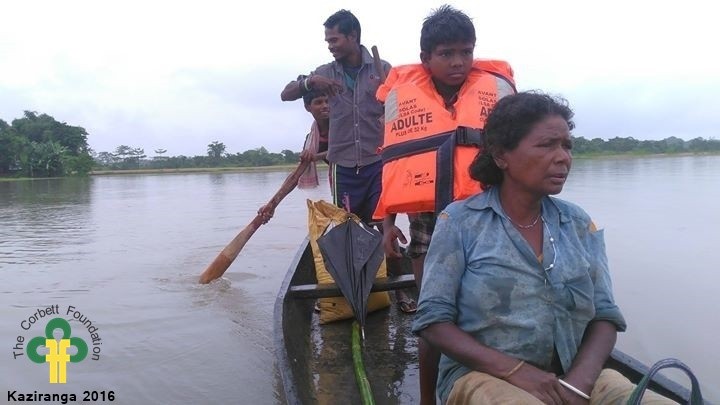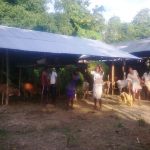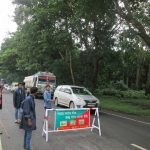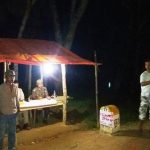
Dr Naveen Pandey, former Chief Veterinary Surgeon of the Darjeeling Goodwill Animal Shelter, Kalimpong, now Deputy Director and Veterinary Advisor to The Corbett Foundation (TCF) in India (www.corbettfoundation.org) shares a summary of his on-going work from Kaziranga, Assam where two-third of the world heritage site, the Kaziranga National Park is under water and millions of people have been affected by the recent floods.
Email naveen.vet@gmail.com.

July 2016 witnessed Assam, in the north-east India, under the worst flood since 1988 affecting lives of millions of people inhabiting the state. Kaziranga Tiger Reserve is under flood too. Transportation and communication to villages has been adversely affected. Majority of the villages and Kaziranga got submerged and people had to take shelter on the roadside on NH37 with their livestock and belongings, which they could carry in haste. Unlike last year, flood water entered suddenly leaving very little time for villagers to plan and flee, and it occurred almost a month before than the annual flooding phenomenon in Kaziranga. The villagers around Kaziranga had to take shelter in school buildings, health centres, on the highway NH37, community centres and religious places. Although, hundreds of villages in other parts of Assam still remain submerged, fortunately the flood water is rapidly receding in the residential areas and villages around Kaziranga. With the flood water receding, people have started moving in their villages but some of the villages such as Jhapooripather are still disconnected from roads as water is flowing over roads and could only be reached on boats. Flood has caused great deal of damage to the roads too. When over two-third of Kaziranga is inundated wild animals naturally are bound to move out. NH37 forms an anthropogenic barrier which animals must cross to reach elevated forests. There are villages scattered around too. Immense human-wildlife conflict could be seen. Road traffic accidents, poaching and deaths are being witnessed. Same could be said about human beings and their livestock.
Kalimpong to Kaziranga has been a journey of life for me, learning lessons of compassion and humanity. My seven-years long stay as a meandering vet in the hills, walking door-to-door treating animals and listening to the stories from villagers, has helped in every bit of my life. At The Corbett Foundation (TCF), as a Deputy Director and Veterinary Advisor, working with one of the most dedicated people for conservation of wildlife, I have been actively conducting rescue operations for wildlife and people almost 24X7.
Rescue operations need interdisciplinary approach as we handle wildlife, livestock and human beings in distress too. Listed below are the flood relief measures being done by my team at TCF around Kaziranga:
- Massive awareness drive was conducted since three weeks prior to flood in 35 villages advising people what to do and what not to do during flood and why not to capture or kill wildlife seeking refuge.
- Flood management meeting with the Kaziranga Park Authority offering to partner with them for flood relief work.
- Distribution of shoes and raincoats to 170 members of Eco Development Committees (EDC) who later worked very closely with us in flood relief work as volunteers.
- 24X7 rescue helpline with over 50 volunteers lending a supporting hand to the Forest Department and CWRC Rescue Centre as the number of wild animals seeking attention was very high between Panbari and Burrapahar.
- Providing veterinary care to 187 livestock through mobile veterinary camps along NH37 and door-to-door in flood-affected villages for the livestock sustaining injuries due to movement or being attacked by wild boars.
- Rescuing villagers who were not able to flee their villages in time with their belongings using TCF’s boat and volunteers.
- Evacuating grain stores of villagers using TCF’s boat from submerged houses when farmers made distress calls.
- Supporting villagers who were attacked by wild animals in the form of transporting them to hospitals and bearing immediate medical expenses.
- Patrolling poaching prone border of the KNP between Teensukey, Dumjan, Bejgaon and Dogaon villages on TCF’s boat by volunteers and informing the Kaziranga National Park Authorities about any suspected movement of poachers and new people in the area.
- Night patrolling on the NH37 and supporting forest guards through refreshments after midnight to ensure that people remained on duty all night.
- Distribution of relief materials in the form of snacks, fruits, candles and matchboxes in temporary shelters. In-kind donations such clothing were also mobilised locally and distributed to the affected villagers.
- TCF has lodged a complaint against a speeding truck that killed an Eastern Swamp Deer on the NH37.
- A total of 90 wild animals have been rescued, including 62 Hog Deer, by the TCF’s rescue team, and these were primarily through community’s involvement. A total of 18 Hog Deer were transported without delay to CWRC (rescue centre), and 44 deer were released to safer locations by TCF’s team after initial examination by its veterinarian. The Forest Department was informed about these rescued animals. Capture myopathy in deer has been observed. A list of wildlife species rescued is appended as Annexure 1 below.
- The highland built by TCF in a village, Jhapooripather, situated at the edge of Kaziranga, served as a shelter ground for nearly 100 families and their livestock. Villagers expressed sincere thanks to TCF for undertaking highland building work in the village.
ANNEXURE 1 – List of rescued wildlife by my team at The Corbett Foundation from 25th to 31st July 2016 in Kaziranga
| Hog Deer | Axis porcinus | 62 |
| Eastern Swamp Deer | Rucervus duvaucelii ranjitsinhi | 1 |
| Rat Snake | Ptyas mucosa | 5 |
| Banded Krait | Bungarus fasciatus | 3 |
| Copperheaded Trinket Snake | Coelognathus radiatus | 7 |
| Lesser Black Krait | Bungarus lividus | 2 |
| Common Wolf Snake | Lycodon capucinus | 1 |
| Monocled Cobra | Naja kaouthia | 4 |
| Burmese Python | Python bivittatus | 1 |
| Checkered Keelback | Xenochrophis piscator | 1 |
| Swamp Francolin | Francolinus gularis | 1 |
| White-breasted Waterhen | Amaurornis phoenicurus | 1 |
| Common Indian Monitor | Varanus bengalensis | 1 |
| 90 |
Wildlife Rescues: (from left to right) Banded Krait, Common Indian Monitor and Hog Deer.
ANNEXURE 2 – Photographs depicting the flood relief work done by my team at TCF
A. Rescue of wild animals
B. Assisting the flood-affected people of Kaziranga
C. Veterinary Camps for livestock
D. Use of highland created in Jhapooripather Village
E. Patrolling along NH37






















Leave a Reply